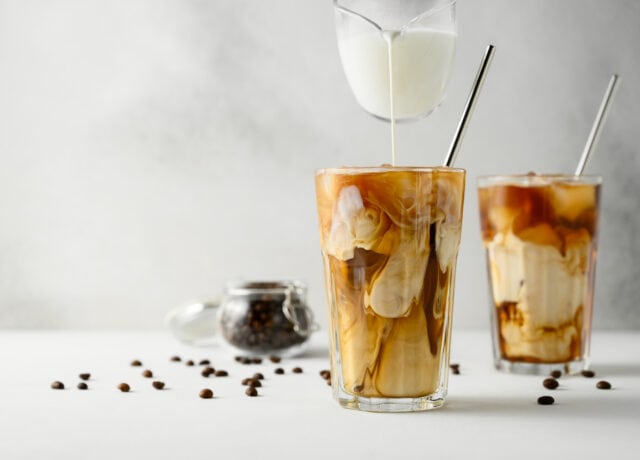You can’t call yourself a true connoisseur of coffee if you don’t know about instant espresso and instant coffee. It’s time to put away your coffee snobbery and come to terms with the fact that instant espresso and instant coffee both have their places in the world.
How are instant espresso and instant coffee different? Instant espresso is popular for flavoring drinks, baked goods, and seasonings. Meanwhile, instant coffee is most famous as a normal coffee substitute.
We’ll look more closely at the differences in instant espresso vs instant coffee in flavor, usage, and creation as we explore them further.

What Is the Difference Between Instant Espresso and Instant Coffee?
Is instant espresso the same as instant coffee? While instant espresso and instant coffee undergo the same creation process, they do have several differences:
- Taste: Instant espresso is a more potent and usually smoother coffee in terms of flavor than instant coffee. Instant coffee sometimes has a more sour taste, too.
- Concentration: Instant espresso is a more concentrated form of coffee than instant coffee. You will usually need twice as much instant coffee than instant espresso.
- Bean quality: Instant espresso often comes from higher-quality beans.
- Bean type: Most instant coffee comes from robusta beans, while most instant espresso comes from arabica coffee beans. Robusta tends to have a more bitter coffee taste than arabica beans.
- Look: Instant coffee is lighter in color than instant espresso.
- Uses: Instant coffee is more commonly used for coffee drinks, while instant espresso is more common in coffee-flavored drinks, baking, and seasoning.
- Caffeine: A cup of instant coffee averages 66 milligrams of caffeine, compared to 58 milligrams of caffeine content in a shot of instant espresso.
What Is Instant Coffee?
Instant coffee granules are powdered pre-brewed coffee. When you add hot water to the powdered coffee, you can instantly create a pot of coffee without having to go through a brewing process.
If you’re a coffee snob, I have some interesting news for you. Instant coffee is more popular in some areas of the world than regular coffee, and half of the coffee drinkers actually prefer instant coffee.
Shocking, I know.
Sometimes, drinking instant coffee is about convenience, such as on a camping trip or when visiting non-coffee drinkers in a small town. However, other times, drinking instant coffee is about tradition.
Often, instant coffee crystals are popular in places with no strong coffee tradition and where there’s not a Starbucks coffee shop on every corner. But instant coffee actually accounts for 34% of worldwide retail coffee, too.
Instant coffee consumption continues to rise yearly. In places like China, where instant coffee beverage consumption accounts for 65%-75% of a $15.5 billion market, instant coffee is easiest to make because it repurposes the traditional teapot as a coffee pot.
I have South American and Australian friends who swear by instant coffee brands like Nescafe. While instant coffee doesn’t have as many fans in the USA, my grandmother couldn’t start her day without a cup of instant decaf Sanka coffee ready to go.
How to Make Coffee with Instant Coffee
The standard instant coffee preparation is:
- 1 teaspoon of instant coffee
- 1 cup hot water
How to Make Espresso with Instant Coffee
The standard preparation for espresso with instant coffee is:
- ½-3 teaspoons instant coffee (depending on how strong you like it)
- 30 milliliters hot water
Baking with Instant Coffee
You can substitute instant coffee in a recipe that calls for coffee to yield the same results.
But, can you substitute instant coffee for instant espresso or a regular espresso shot? You can substitute two teaspoons of instant coffee powder for one teaspoon of espresso powder or a single shot of espresso in a recipe.
However, it won’t yield the same rich flavor results that espresso or instant espresso would lend to a recipe.
What Is Instant Espresso?
Instant espresso coffee is powdered pre-brewed dark roast coffee. When you add hot water to the powdered coffee product, you can instantly create a cup of espresso without an espresso coffee machine.
Espresso powder can also deepen the taste of chocolate in baking recipes, add coffee flavor to drinks, and be a seasoning additive.
Espresso powder, however, is not the same thing as instant coffee. It’s much more concentrated than instant coffee and will give a smoother and more robust, darker flavor than instant coffee can.
How to Make Coffee with Instant Espresso
You can make instant coffee with espresso powder. Here’s the standard preparation:
- ½ teaspoon instant espresso
- 1 cup hot water
How to Make Espresso with Instant Espresso
The standard preparation of espresso from instant espresso powder includes:
- 1 teaspoon instant espresso
- 30 milliliters hot water
Cooking and Baking with Instant Espresso
Instant espresso powder is a secret ingredient many bakers use to make the chocolate taste more chocolatey. Adding a pinch of instant espresso coffee in baking recipes elevates the flavor of brownies, cakes, and other chocolate treats without making them taste like mocha.
You only need to add one teaspoon of instant espresso to a recipe to give your baked goods a more complex, deep chocolate flavor. Add instant espresso to your sweet treat at the same time you would add cocoa powder.
Adding Instant Espresso to Drinks
Just like you can add concentrated shots of espresso to drinks for more coffee flavor, you can add instant espresso powder to hot cocoa, smoothies, or cocktails. Try just a sprinkle or up to a teaspoon to mimic the taste of espresso without added liquid.
Using Espresso Powder For Seasoning
Espresso powder, sometimes called espresso crystals, is especially popular in dry rubs and spice blends. It can add flavor depth to roasted meats, braises, sauces, and stews.
How Are Instant Coffee and Instant Espresso Made?
Have you ever wondered how coffee roasters make instant coffee or instant espresso? Well, wonder no more. Making instant coffee and instant espresso starts with a concentrated brew of ground coffee beans followed by a drying process to remove moisture.
The History
The British Government patented the first instant coffee in 1771 as a “coffee compound.” In 1890, a New Zealander named David Strand made a water-soluble coffee using a “dry hot-air” process.
However, it wasn’t until 1910 that chemist George Constant Louis Washington created the first mass-produced coffee crystals, which supplied American soldiers with a morning cup of coffee in World War I. Today, we drink a Cup of Joe, but they drank a Cup of George.
Luckily, today’s instant espresso-making process leaves fewer chunks of coffee floating in your cup than the instant coffees and instant espressos of old.
The Beans
The main differences between instant espresso and instant coffee are the type of roasted coffee beans and the roast rather than the instant powder-making process.
Instant espresso starts with a more robust roasted coffee, usually from arabica espresso beans. Meanwhile, instant coffee starts with regular roasted coffee, usually from robusta beans.
The difference between arabica and robusta coffee beans is that the arabica coffee bean is sweet, light, and smooth, while robusta is a harsher and more bitter low-quality coffee.
The Brew
Making instant coffee and instant espresso involves brewing roasted beans to make a concentrated coffee extract.
The Drying Process
After brewing, instant coffee makers dry the coffee extract to remove the water. There are two different processes for drying coffee, which preserve the coffee’s flavor and aroma:
- Spray drying: Coffee makers spray the coffee into hot air, where it quickly dries and turns into dehydrated coffee crystals.
- Freeze drying: Coffee makers freeze the coffee, cut it into small pieces, and then dry it out at low temperatures in a vacuum.
Final Thoughts on Instant Espresso and Instant Coffee
Instant espresso and instant coffee are very different in flavor and serve different purposes.
Even if you don’t drink them every day, instant coffee and instant espresso are great to have on hand.
Instant espresso can add coffee flavor or deeper flavors to beverages, baked goods, and spice mixes. Meanwhile, instant coffee can function as a coffee substitute when your favorite coffee-making method isn’t available.
Happy Caffeinating!







